Learn how to make Fermented Hot Sauce – a simple way to enhance and preserve your abundance of garden chilies to use throughout the winter. Full of healthy probiotics, this easy recipe has many health benefits. Plus it just tastes good! Video.
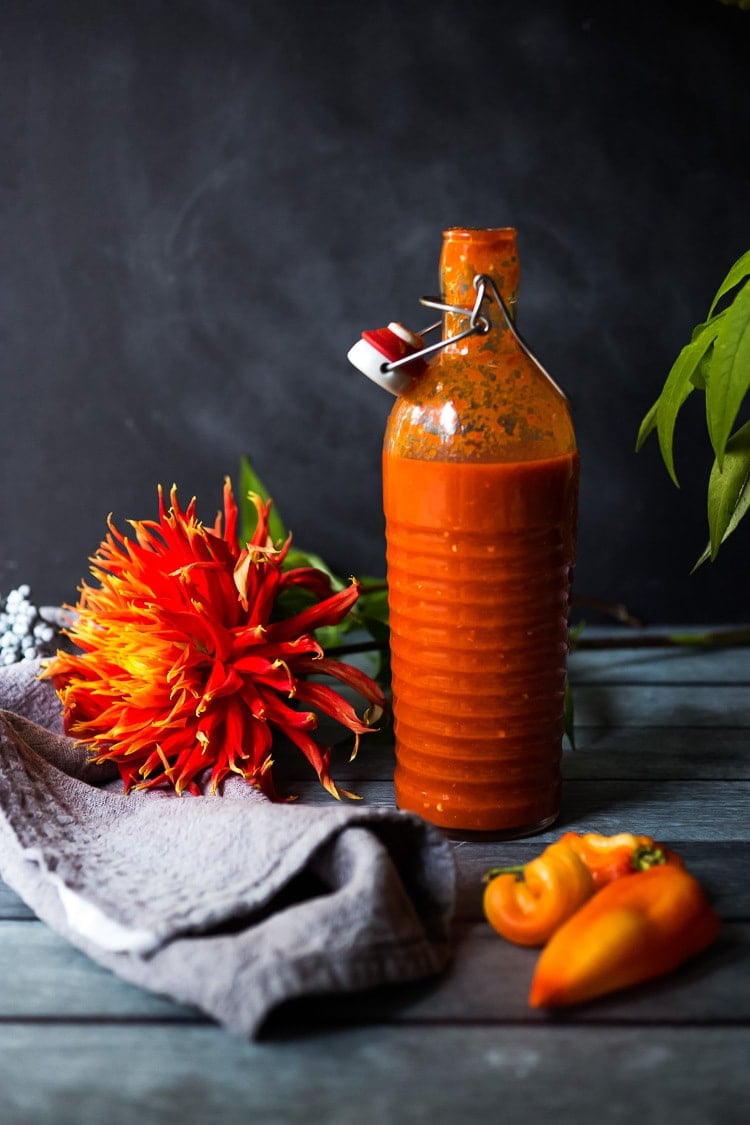
For many of you with gardens out there, this is the season of harvesting. Here’s a simple way to use all those chilies you’ve got growing out back and turn them into something that will bring you a little kiss of sunshine during the cold months – Fermented Hot Sauce! Now, before you feel intimidated – know that this only takes 20 minutes of actual hands-on time and no special equipment. It’s ridiculously easy!
Why I prefer fermenting over canning:
- Healthier: Fermentation creates “ALIVE” food- incredibly rich in probiotics. These good bacteria are living creatures that work with our microbiome to improve digestion, boost immunity, and prevent disease. Having a diverse microbiome is healthy! Canning “kills” all these healthy probiotics through the heating process.
- Taste: I prefer fermentation over “canning” because fermentation keeps these healthy bacteria alive, and as a result, the fermented food actually tastes better and better with time! Canning halts the development of flavor.
- It’s easier: Canning requires more hands-on time.
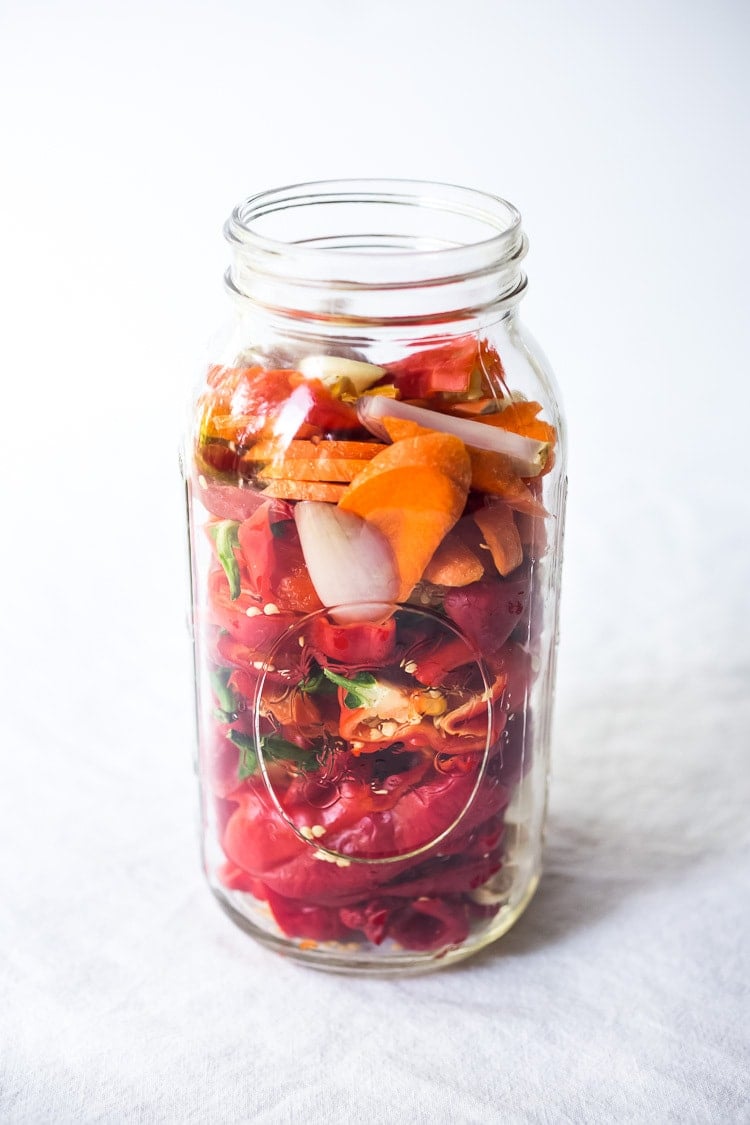
How to make Fermented Hot Sauce:
Step one: Fill a clean 2-quart jar with any type of fresh hot chili, onions, garlic and thinly sliced carrot. You can use bell peppers to temper the hot chilis if you want a milder version. Just stick with the same color palette so your fermented hot sauce stays colorful and vibrant.
In this recipe, I used Padrone Peppers, a Spanish variety that had turned red, which I found at our farmer’s market. But feel free to use any kind you want or a blend. You’ll need about 1 pound in total. (You can easily halve this recipe)
Step two: Make a saltwater brine, using 1 1/4 teaspoons fine sea salt, per 1cup of water.
Salt Ratio for Fermentation:
Having the right proportion of salt to water is important. Not enough salt may allow unhealthy bacteria to grow. Too much salt will kill all the bacteria and the chilies won’t ferment. If you need to add more water to the jar, then add salt accordingly.
Use 1 1/4 teaspoons fine sea salt per 1 cup of water. This is roughly a 3% Brine (3 grams of salt per 100g of water).
Here, I used 5 cups of water, so I added 1 1/4 teaspoon salt x 5 cups water = roughly 6 1/4 teaspoons of fine ground sea salt. Heating the water slightly helps the salt dissolve.
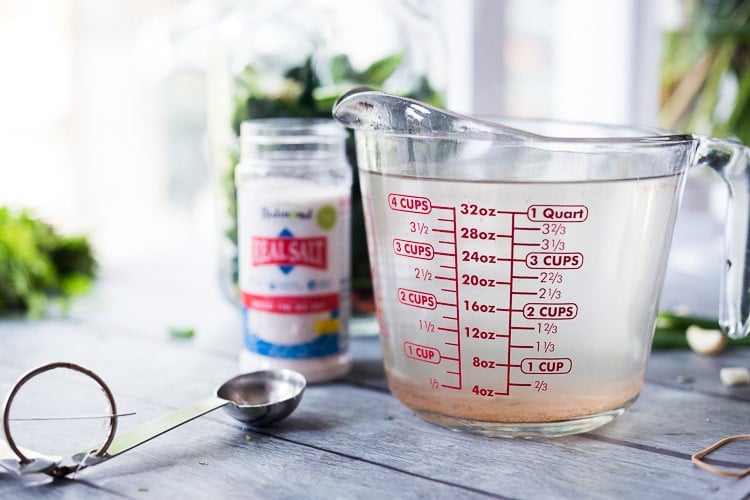
Step Three: Combine! Pour the brine over the chilies and push them down so they are completely submerged under the brine. Feel free to cover the chilies with a cabbage leaf to keep everything down, then weigh them down.
Step Four: Weigh down the chilies. You can use a fermentation weight, like this version that I really like, that will fit perfectly into a mason jar, to keep everything submerged. If anything floats to the top, and touches air, this can potentially mold, so either fish it out with a slotted spoon, or push it down under the brine.
Or in a pinch, a zip lock bag filled with water can be used as a weight, just place this over top. I prefer using a glass or ceramic weight.
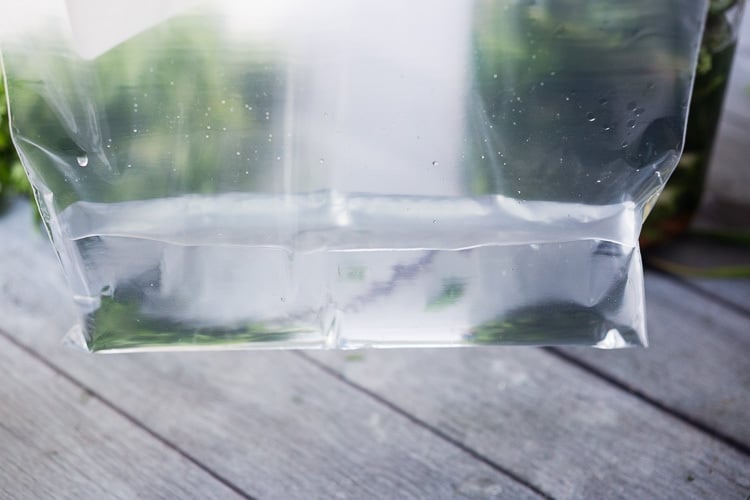
The water in the bag will work as the fermentation weight here. A small clean shot glass, placed over a cabbage leaf, can also act as a fermentation weight as well.
Here you can see I’m working on a mild green hot sauce which is in the fermenting phase still.
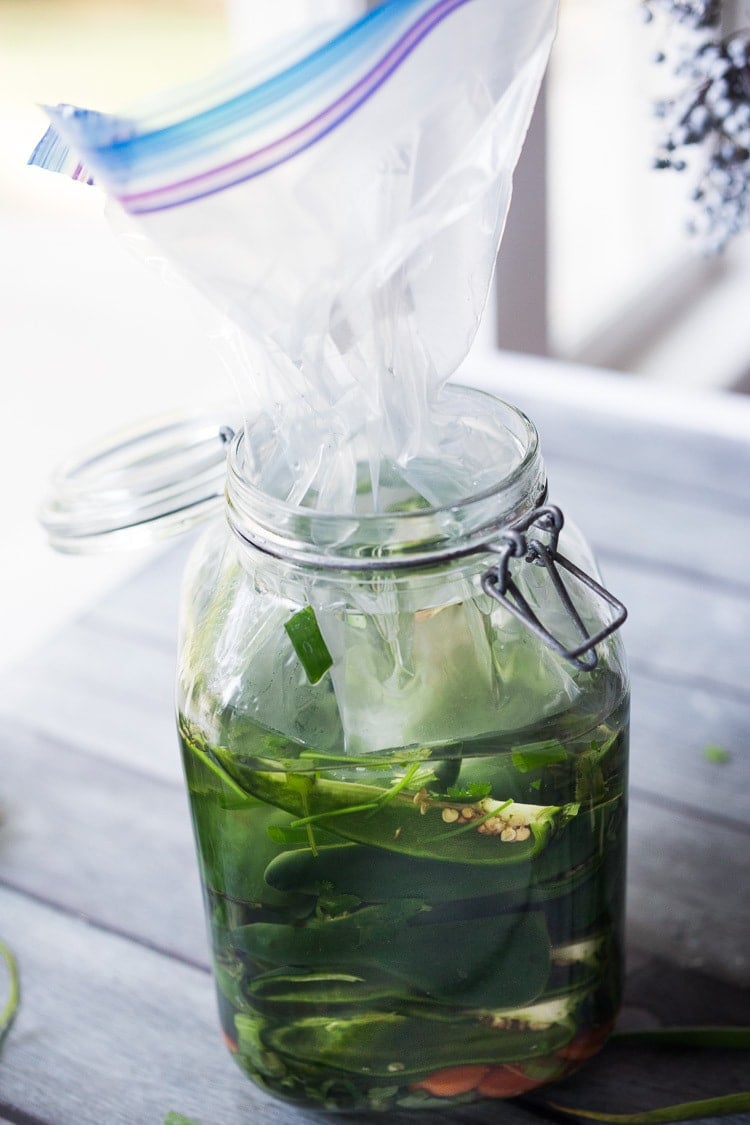
Step Five: Place a lid on top, leaving it loose. You want the fermentation gasses to be able to escape while keeping any creatures (bugs, flies) out. A couple of layers of cheesecloth also work here.
Step Six: Place the jar in a bowl or pan to catch any liquid that may spill over, and place it in a cool, dark place, like a basement. 65F-70F is ideal. If you don’t have a basement or a cool place, a lower cupboard in the kitchen is an option.
Check every few days, removing any “floaters”. After a few days, the brine will turn slightly cloudy, and when you tap the jar, you should see little bubbles float to the surface or some overflow on the pan- all signs of life!
Ferment 5-10 days. I usually go 7-12 days, long enough to soften those carrots, which you will be blending up in the sauce.
If, for some reason, you are going out of town, you can always place the ferment in your fridge, which will slow it down, but keep it alive, and you can resume when you get back.
Why is the Brine Cloudy?
Cloudy, tangy brine is a natural by-product of the fermentation process- a combination of lactic acid and yeast- and is the reason why they call it Lacto-fermentation.
Various strains of bacteria are present on the surface of all plants, especially ones growing close to the ground. Lactobacillus bacteria convert sugar into lactic acid, preserving the peppers.
Both salt and lactic acid prevent the growth of harmful bacteria. Over time, the cloudiness can settle out of the brine to the bottom of the jar. Some batches are naturally cloudier than others, but all are safe to consume.
A cloudy brine is a sign that you have a safe, successful, and tasty ferment.
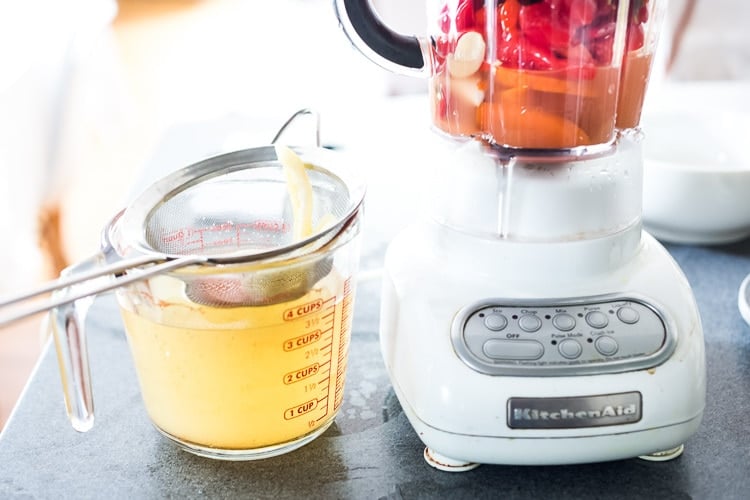
Step 7: Blend! Strain the brine, saving it. Add the strained chilies/carrots/garlic to the blender with one cup of brine and blend until smooth, a least a minute! At this point, you can add herbs (oregano or cilantro is nice here) and spices (cumin, coriander, chipotle). Add a little splash of Braggs apple cider vinegar if you like (this is optional but also full of healthy bacteria) and more brine to desired consistency.
If you like the idea Sriracha, you could also make it sweet by adding sugar or honey, and perhaps ginger. You could also add herbs.
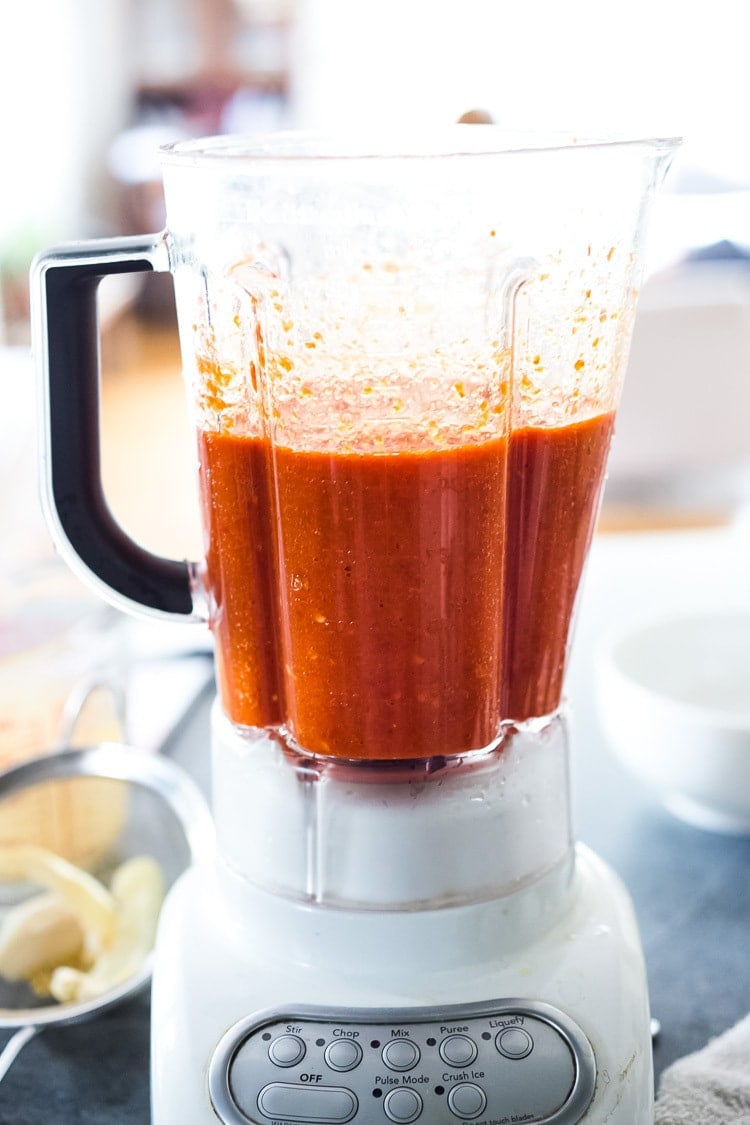
Step 8: Store! For everyday use, store the fermented hot sauce in squeeze bottles– leaving the tip off or open (or lightly closed) in the fridge. The hot sauce will continue to ferment in the fridge, and the open tip will allow the gasses out. Before using, cover the tip with your finger and give it a good shake.
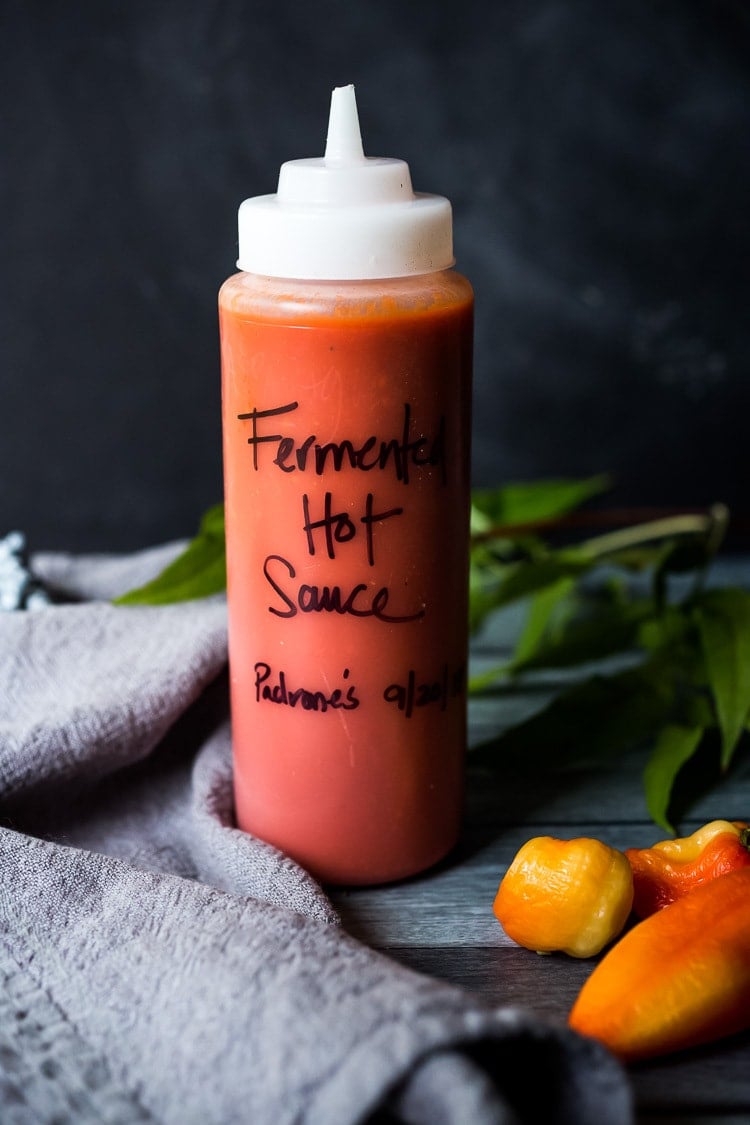
A little Warning!
If you place the fermented hot sauce in tightly sealed bottles, unrefrigerated, they will EXPLODE! This is because the hot sauce is still fermenting (producing gases) and will continue to create bubbles. Remember, it is alive, and this is NOT canning.
*If giving as a gift, yes, feel free to use a “cute bottle” but with instructions to refrigerate and loosen the lid.
But my hot sauce is way too hot!
Don’t be too alarmed if your hot sauce tastes overly hot when you first store it. After a week or two in the fridge, the gradual slow fermenting will substantially mellow out the heat! It’s quite surprising. Many times, I’ve made a hot sauce and tried it, thinking there was no way we would be able to eat it because of the heat level. But after a week or two, it really does calm down the heat. Fermenting the hot sauce gives it another layer of flavor, adding more and more complexity. This will keep indefinitely in the fridge.
Types of chilies to use:
Use any fresh chili pepper you like or a blend of different peppers (in the same color palate). To temper the heat, feel free to add similarly colored bell peppers (red, yellow, or green bell pepper). For example- add a golden bell pepper to habaneros to temper the heat. Or a green bellpeper to serano chilies.
Keep in mind you will be blending the sauce, so stick with the same color palate to make a vibrant-colored sauce. For example, mixing red and green peppers will yield a brown hot sauce- not the prettiest, but up to you. 😉
Also, keep in mind that fermentation will mellow out the heat of the peppers over time.
I am hearing that frozen peppers can be fermented ( please read the comments), but have not personally tried this.
Helpful tools
- Fermentation Kit (optional)
- Fermentation weights
- 2-quart mason jar (8-cup mason jar)
- Blender
- Strainer
- squeeze bottles
Making Fermented Hot sauce is a fun little project that only takes about 20 minutes of hands-on time. A lovely way to use up all the chilis in your garden (or a way to try out all the beautiful varieties at the farmers market) and a healthy way to bring more healthy probiotics into your life!
Mother Nature will do all the work for you! And after 5-7 days, you will end up with the most delicious, alive hot sauce that will get better and better with age!
Troubleshooting
- If there are no signs of fermentation, double-check you measured the salt ratio correctly. This is typically the most common problem (adding too much salt will halt the process and kill all the bacteria, even the good ones.).
- Try filtered water. Chlorinated water can halt fermentation.
- Do not over-wash or peel the peppers/carrots (for example, don’t use any type of produce soap) as the wild bacteria from the pepper skin, carrot peeling is what is starting the fermentation. I have the best luck with farmers’ market chili peppers and carrots because they are not over-cleaned or treated with anything.
- Mold: If your ferment has molded, something likely rose to the top of the jar and had contact with air. I would start over.
- Bad smell: the brine should smell tangy, garlic, and fresh, not “foul” in any way! If it smells “off,” it could be that salt was mismeasured or the ferment was contaminated: dirty hands, dirty utensils, dirty jar.
More Favorite Recipes!
- Yum Yum Sauce
- How to Make Kimchi!
- Simple Cabbage Sauerkraut
- Beet and Cabbage Sauerkraut
- Probiotic Gut Shot
- Curtido & Cultured Salvadoran Slaw
- How to make Fermented Pickles!
More from Feasting At Home
Watch HoW to make Fermented Hot Sauce!
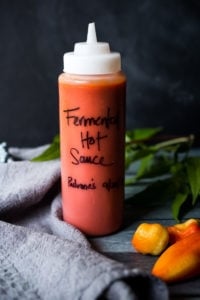
Fermented Hot Sauce
- Prep Time: 20 minutes
- Cook Time: 5 days
- Total Time: 120 hours 20 minutes
- Yield: 4 cups
- Category: Sauces, fermenting, preserving
- Method: fermenting
- Cuisine: American
- Diet: Vegan
Description
A simple, delicious recipe for Fermented Hot Sauce using fresh summer chilies, with no special equipment and only 20 minutes of hands-on time!
Ingredients
- 5 cups filtered water
- 6 1/4 teaspoons finely ground sea salt (or Pink Himalayan salt) – use 1 1/4 teaspoon salt, per 1 cup of water.
- 2 Quart Mason Jar
- 16 ounces fresh chili peppers, sliced in half (about 6-7 cups) seeds & stem removed, see notes
- 1 carrot, very thinly sliced 1/16th-inch (do not peel!)
- 4-8 garlic cloves, cut into quarters
- 1-2 shallots, sliced (or 1/2 an onion)
- optional: herbs (oregano, cilantro, celery leaves) and spices (cumin, coriander, chipotle powder, smoked paprika)
- 1-3 tablespoons apple cider vinegar, (optional- for extra tang and for more healthy probiotics)
- honey or sugar to taste (optional, good if making Sriracha style)
- If your hot sauce is not hot enough, you can always add cayenne or ground chipotle to taste. Free free to add spices ( 1/2- 1 teaspoon) cumin, coriander, chipotle, allspice, etc. Make this your own.
Instructions
- Wash your hands, jar and ustensils. Not sterilized, just clean. 🙂
- Stir sea salt into the water until dissolved.
- Slice the small hot peppers in half, and remove stems and seeds if you like (for less heat). If your pepper are very hot, wear gloves. If adding bell peppers to temper the heat, cut into thin strips. Thinly slice the carrot (do not peel), slice the shallots, and slice the garlic.
- Layer all into a clean 2-quart mason jar. Top with a cabbage leaf to hold things down (optional) and pour the brine into the jar over the chilies, pressing them down under the liquid. If you need to add more brine, remember to use the ratio of 1 1/4 teaspoon salt per 1 cup of water.
- Weigh everything down with a fermentation weight (or use a small ziplock bag filled with water to weigh the veggies down or try a clean shot glass). You want the chilies completely submerged under the brine. Anything that touches air, may mold, so either spoon it out or push it down. Cover loosely with a lid ( or cheesecloth and rubber band) and place the jar in a pan or bowl to collect any liquid that may bubble over. The lid is loose here so gasses can escape easily, but no creatures can get in.)
- Place in a cool dark place, like the basement, 65-70F is ideal, (or the bottom cupboard in the kitchen) for 5-10 days or until signs of fermentation.
- On day 3-5: Check for fermentation: Tap the container and see if any tiny bubbles rise to the surface, check for a cloudy brine ( see notes) or check the bowl underneath, to see if there was any overflow. All signs of activity! Ferment 7-10 days, long enough to soften those carrots that you will be blending. And you can always ferment longer for even more flavor- I’ll often ferment 12 -14 days. Sometimes I’ll ferment 7 days, then place the jar in the fridge for a few weeks before blending. The longer the ferment, the tangier and more flavorful this will become, and the more mellow the heat. *If there are no signs of fermentation, give it a couple more days- then check the troubleshooting section in the post.
- After 7 days and signs of fermentation, strain and SAVE the brine. Place the fermented peppers, onions, garlic, and carrots into a blender and discard the cabbage leaf. Add 1 cup of the brine and blend until smooth as possible. This may take a couple of minutes. Add the vinegar if using, (and honey if you prefer a sweeter hot sauce like Sriracha), and more brine to desired thickness. At this point, you can blend in optional spices and herbs. ( 1/2-1 teaspoon spices, 1-2 tablespoons fresh herbs).
- Don’t be alarmed if it is overly spicy- the heat level will significantly mellow with time, as it continues to ferment in the fridge after 1-2 weeks. Place in a squeeze bottle and store in the fridge, leaving the tip open (or loose) for gasses to escape.
- Do not place in a sealed jar unrefrigerated– this will result in an explosion– and a great big mess- as the hot sauce is still alive and fermenting! BE WARNED! I have the best luck with using in squeeze bottles and leaving the cap off in the fridge.
- If transporting to a friend as a gift, it is ok to seal for short periods of time (a few hours) but make sure to tell them to refrigerate it and loosen the lid, very soon after receiving.
- The flavors will continue to develop and get more complex over time, the heat mellowing.
- To use, cover the tip of the opening with your finger and give a shake before using.
- This will keep up to 12 months in the fridge (probably even longer!).
Notes
WATER: Regular tap water may contain too much chlorine in it, inhibiting the fermentation process (although our tap water works fine). If fermentation is not happening, you may want to try filtered water.
SALT: I use fine ground sea salt or Pink Himalayan salt . If using coarse ground salt you may need to add a pinch more.
Peppers: Use any chili pepper you like or a blend of different peppers (in the same color palate). To temper, the heat, feel free to add similar colored bell pepper -substitute sweet red, yellow, or green bell pepper. Keep in mind, you will be blending the sauce, so stick with the same color scheme to make a vibrant colored sauce. For example, mixing red and green peppers will result in a brown hot sauce– but up to you. 😉 Also, keep in mind, the fermentation will mellow the heat a little. Removing the seeds will help temper the heat.
RATIO: If you need more water to cover or fill the jar, use 1 1/4 teaspoon salt per cup of warm water.
You could easily halve this recipe or use two, quart-sized jars.
CLOUDY BRINE: A cloudy brine is a natural by-product of the fermentation process-a combination of lactic acid and yeast and is the reason why they call it Lacto-fermentation. It is a sign of fermentation. Various strains of bacteria are present on the surface of all plants, especially ones growing close to the ground. Lactobacillus bacteria convert sugar into lactic acid, preserving the peppers.Lactic acid prevents the growth of harmful bacteria. Over time the cloudiness can settle out of the brine to the bottom of the jar. Some batches are naturally cloudier than others, but all are safe to consume and taste delicious. A cloudy brine is a sign that you have a safe and successful ferment.
Signs of fermentation: liquid overflowing into the bowl (check the bowl to see if the jar overflowed, a good sign! Tiny bubbles rising to the top when you tap the jar. Cloudy brine, tangy flavor or smell.
Nutrition
- Serving Size: 1 tablespoon
- Calories: 4
- Sugar: 0.4 g
- Sodium: 112.3 mg
- Fat: 0 g
- Saturated Fat: 0 g
- Carbohydrates: 0.9 g
- Fiber: 0.2 g
- Protein: 0.1 g
- Cholesterol: 0 mg
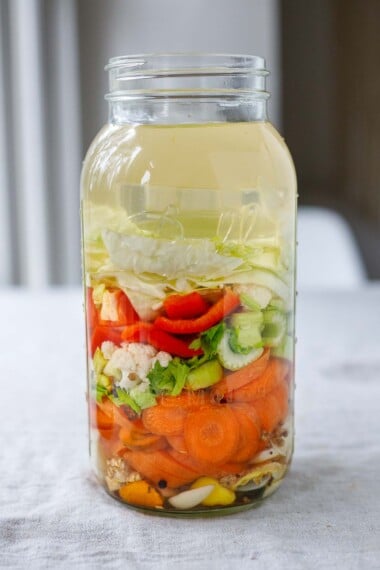
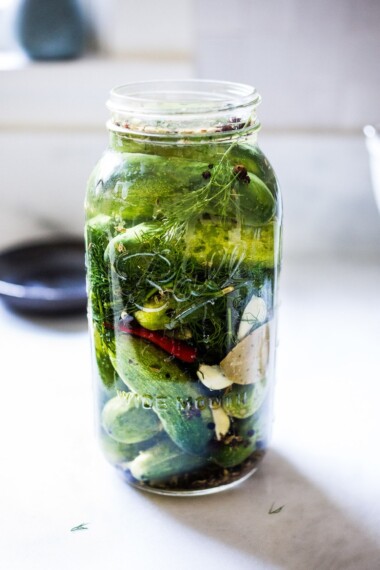
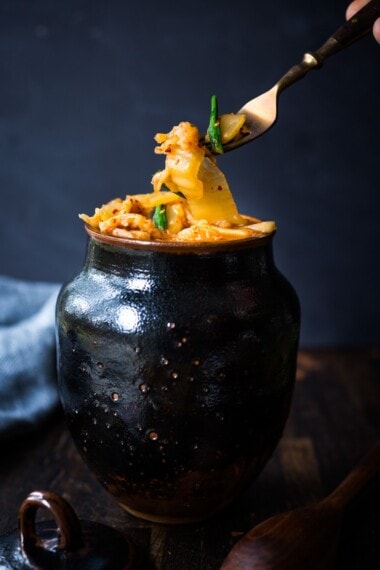
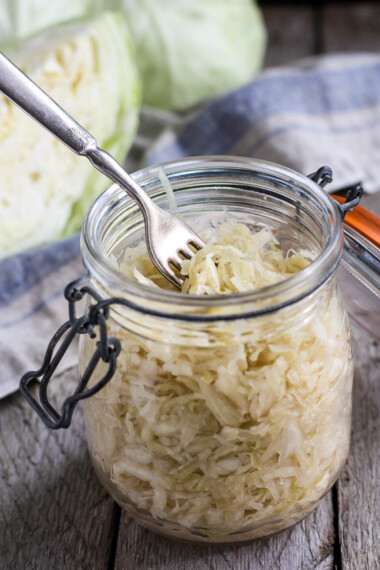
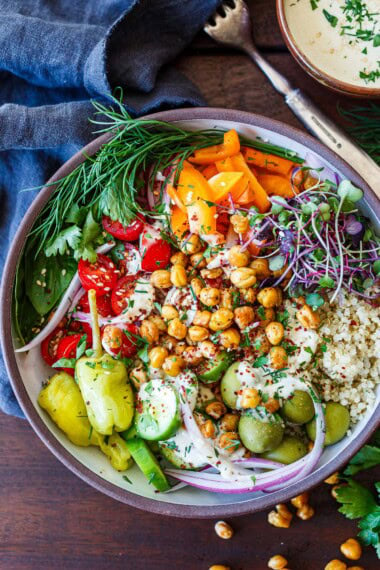
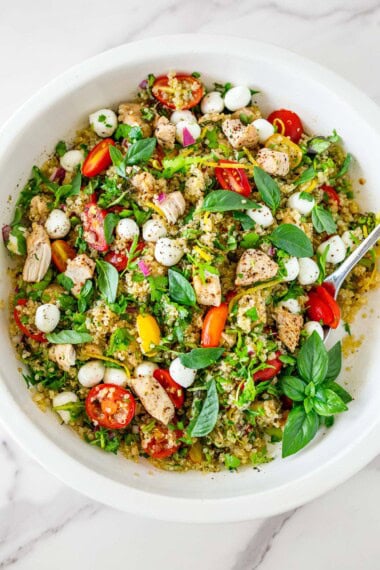
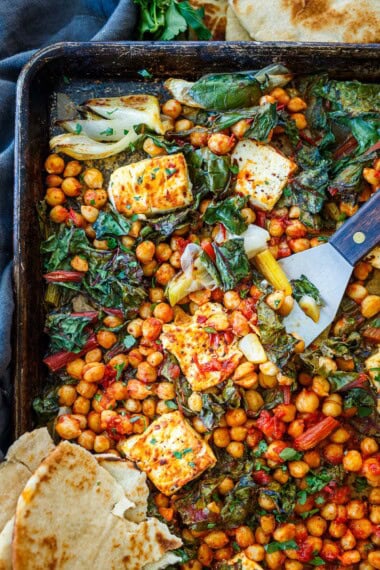
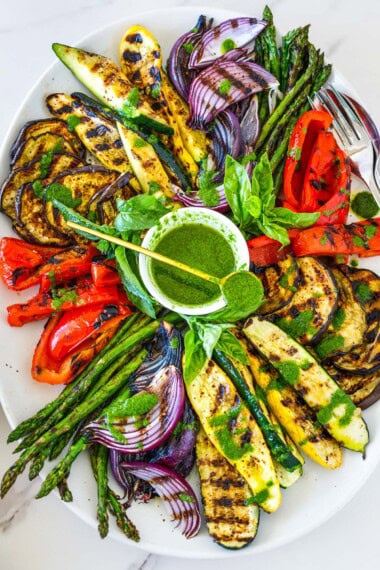


If I heat the sauce after blending, will it stop the fermentation?
Yes, it will.
This recipe sounds amazing, and there are many great tips listed. It will be another month before I try this out because my peppers need longer to grow. My question is, do you see it being an issue if I add some halved and cored Roma tomatoes to the mix before the fermentation process begins?
Hi Jake! Great question. I’ve never fermented tomatoes, but don’t see why this wouldn’t work? I’ll give it a try next batch- my peppers are just about ready too and I’ll report back.
I have used this recipe a bunch. It’s really great (so thank you). My brother and his fiancee had many pounds of late-season green tomatoes last year that I added and fermented with their jalapeno peppers. And it worked well! I’m sure ripened tomatoes will work.
Great to hear Andrew and thanks for the tip on the tomatoes!
I made a batch last year ready to make a new batch cant wait so good.
Awesome Mike! I just made my first batch this summer- so good!!!
What ratio of hot pepper (using habanero) to bell pepper to you suggest to make it medium heat?
Hi Kathleen, that is a great question, and I’m not sure, habanero’s are sooooo spicy. I would personally do 1/4 habanero and 3/4 orange or yellow bell pepper. But this is a total guess! Will you let me know how it turns out?
A question : I make my own fermented veggies, using kefir liquid and filtered water (plus salt, spices, etc) – could I use this combination with your fermented chilli recipe?
I haven’t tried, but if you are fermenting veggies, then I don’t see why this wouldn’t work? Sounds intriguing Heid!
I am so excited to go to my local farmers market tomorrow and scope out some peppers for this recipe. Sylvia, would you be able to give me some approximate measurements for the herbs/spices you added to your sauce? Just so I have something to go off of? Thanks you for all the delicious ideas you share with us on here!
Sure I will add to the recipe card.
How long do I have to wait to bottle it? I’d like it to look professional when I gift it out.
I’d give it a week in the fridge so flavors develop. 🙂
Why do you say “Lightly close the lid”? Is it supposed to be loose so air can get in?
Why do some cover it with cheesecloth?
Am I supposed to ferment all the fruits and veggies and fruit juice that goes into the sauce, or just the peppers onions and garlic?
Everyone say’s this is so easy but every article I read has completely different methods.
So confusing.
I wish someone could point me to a article that covers all the bases.
Hi Aaron, I hear your frustration. I updated the post to make it more clear- so thanks for your suggestions. To answer your questions: Place a lid on top to let gasses out but prevent little creatures (bugs) from getting inside. Cheesecloth accomplishes the same thing. I like to ferment everything- fruits and veggies – but you can also just ferment the peppers/onions/garlic- both ways work. The recipe is pretty flexible- meaning- there are a lot of ways to achieve the same thing here. Most important is measuring the salt.
I omitted the carrots and replaced it with pineapples and added whole peppercorns and 2 bayleaves. I like my sauce garlicky so I added a bunch of that as well. Also used Carolina Reapers.
It’s gonna be super hot. Will let you know in 2 weeks.
Sounds so good Keysi! Love the pineapple!
What ratio of sugar would you add? And do you need to dissolve it in boiling water or something first??
I would add it “to taste”, to the blender, no need to dissolve. Perhaps start with 1-2 teaspoons, then more to taste. Honey would also work great here too.
Thanks!
Hi Sylvia
I made this hot sauce and it’s really hot 🥵- is there anyway I can temper it now that the fermentation is done? Also, can I use the leftover brine for other stuff?
Cheers
Kim
Use the leftover brine for seasoning soups or stews. Give the sauce a week or two in the fridge- it really will mellow!
I used my brine a second time(had to add a bit more) and fermented asparagus in the hot brine. It’s great garnish to a bloody mary or even grilled.
OH! What a great idea!Love this idea Tom- thanks so much! Will have to try it.
I made fermented hot sauce. I just blended it in blender and it is WAY too hot for my palate. I didn’t leave any seeds in either. Also I added other veg with it when it was fermenting. I can’t seem to get help on diluting. Some say boil it down, others, add vinegar ( I don’t want to do that ) And I read that adding pumpkin could help take away some heat. If I add pumpkin puree will it still stay good in the refrigerator for a long time? I also though of adding apple puree I made. Any suggestions?
Okay I found the answer on here thanks
The heat will mellow after a few weeks in the fridge. I would wait to add anything!
Does fermentation ever fail? My brine doesn’t look cloudy. No bubbles. I am using Pickle Pipes. Has been in for 10 days.
Dave, sometimes it does. Not very often, but yes, it happens. I’m sorry. Frustrating, I know. It is possible you over-measured the salt? I’ve don’t that, and it prevents fermentaion. That would be my first guess. But not sure here.
Dave, sometimes it does. Not very often, but yes, it happens. I’m sorry. Frustrating, I know. It is possible you over-measured the salt? I’ve don’t that, and it prevents fermentation. That would be my first guess. But not sure here.
I just want to say that that trick with the water in a zip-locked bag is pure genius! Thanks!
Hi! I just finished making this hot sauce, literally 5mins back. And was reading notes and comments when I saw the short video and realized I’ve cut up the red chilies into big pieces, where as you’ve kept them whole . Is the sauce ruined, you think? Let me k ow please as soon as you can.
It’s fine! no worries here. 🙂
i put all mine in a blender after i cut the stem off over all it seems to be working well
i used a 1tb 1/2 tbs per cup of water
I used your recipe as a guide, and I have two small batches of habanero, carrots, and garlic fermenting. I was thinking that when it comes time to process into a sauce, I would like to add something sweet (like pineapple, peach, or mango). Then I would keep it in a squeeze bottle in the fridge like you suggest. Do you see any issue with this in regards to spoiling?
Not at all- Sounds tasty!
I made this using a combination of Thai and Habenero peppers. The sauce was hot but it also had a sour taste to it which I do not care for.
The sour is from the fermentation.
This worked great! I used an anonymous korean green pepper and thai chili pepper. The tip about the bag filled with water as a weight was also super helpful. I can’t believe I’ve never come across that idea before! Fermented for 7 days and now it’s in the fridge 🙂
Great! Glad it worked for you!
Side note, I used the leftover brine to pickle collard green stems and it made delicious, spicy pickles!
Love it!!!
I made my first batch today following this recipe with a few slight modifications and it came out really, really nice – thanks for sharing! My wife who does not care for hot/spicy things even asked what smells so good when she walked in the kitchen.
I have a question for you. I did save off the brine that was left and was wondering if I can use that for my next batch of fermented peppers and just top it off with the proper ratio salt water. Or would you recommend starting with fresh salt water with no cloudy fermented brine at all?
I would start fresh- but the brine is really tasty in soups!
Q: once the peppers have fermented after the 7 day period, can I use vinegar instead of the cloudy brine as the liquid in the blender? Or is it crucial to use at least some of the cloudy brine? TIA
The brine will allow it to keep fermenting. Plus it adds great flavor. You really want it!
I tried five different fermented hot sauce recipes this fall with my garden produce. This one was my fave. Absolutely delish!
Yes! 🙌
I have just started this recipe with jalapeños and green bell peppers with a little bit of celery instead of carrot. Given the colour, I omitted the carrot but, wondering if there is a chemical purpose for the carrot that I’ve overlooked.
Nope, that should be fine!
Hi Sylvia,
Sounds like a great recipe. I have 2 questions before I try it however:
1. Can frozen peppers be use? I have frozen tabasco and habanero peppers from a previous harvest. I’m concerned that freezing them may have killed off the bacteria needed to cause fermentation.
2. What room temperature is is recommended for good fermentation? It is winter time here and we typically keep our house at around 67 degrees. Is that to cold?
Cold is good. I like to place mine in our 60-65F basement. To my surprise,some people are having luck with fermenting frozen peppers which honestly, I don’t understand, because I thought the bacteria die as well, but apparently, they seem to come back to life? If I were to try this, I’d test with a small batch (one jar), and perhaps include one fresh pepper (like 1/2 a bell pepper) along with the carrot?
great recipe. from other people makeing hot sauce (like chilli chump on YouTube) they say to use 50/50 mix of fresh and frozen as the frozen have little to no living bacteria.
At work we store fungi, bacteria and virus frozen at -80 degrees celsius and they all come back. I think their endospores lie dormant at a certain temperature but then start reproducing again once defrosted. I would thaw the peppers before fermenting. I am not an expert though.
It sounds like you are though! Thanks, this is helpful! I will have to try.
Woohoo! I made hot sauce! 😉 This recipe was great and so easy to follow. My peppers got nice and cloudy without any mold. It made some very yummy hot sauce. Can’t wait to try a new batch!
Awesome Nicolette, great to hear! 🙌
I have made a very large batch. Can I safely freeze in containers (freezer safe) to store once I have completed the fermentation process and blended?
So I’m not clear on whether freezing would stop or kill the heathy probiotics in the hotsauce. I don’t think it affects the taste though.